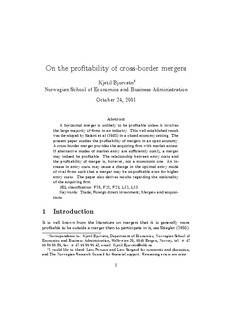| dc.contributor.author | Bjorvatn, Kjetil | |
| dc.date.accessioned | 2006-08-10T11:12:19Z | |
| dc.date.available | 2006-08-10T11:12:19Z | |
| dc.date.issued | 2001-10 | |
| dc.identifier.issn | 0804-6824 | |
| dc.identifier.uri | http://hdl.handle.net/11250/162950 | |
| dc.description.abstract | A horizontal merger is unlikely to be profitable unless it involves
the large majority of firms in an industry. This well established result
was developed by Salant et al (1983) in a closed economy setting. The
present paper studies the profitability of mergers in an open economy.
A cross-border merger provides the acquiring firm with market access.
If alternative modes of market entry are sufficiently costly, a merger
may indeed be profitable. The relationship between entry costs and
the profitability of merger is, however, not a monotonic one. An increase
in entry costs may cause a change in the optimal entry mode
of rival firms such that a merger may be unprofitable even for higher
entry costs. The paper also derives results regarding the nationality of the acquiring firm. | en |
| dc.format.extent | 195996 bytes | |
| dc.format.mimetype | application/pdf | |
| dc.language.iso | eng | en |
| dc.publisher | Norwegian School of Economics and Business Administration. Department of Economics | en |
| dc.relation.ispartofseries | Discussion paper | en |
| dc.relation.ispartofseries | 2001:14 | en |
| dc.subject | trade | en |
| dc.subject | foreign direct investment | en |
| dc.subject | mergers and acquisitions | en |
| dc.title | On the profitability of cross-border mergers | en |
| dc.type | Working paper | en |
